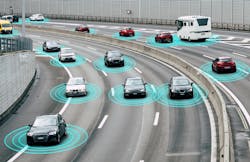New NEMA Committee to Develop Vehicle-to-Infrastructure Communications Standards
The National Electrical Manufacturers Association (NEMA), Rosslyn, Va., is forming a new committee to develop technical specifications for roadside connected-vehicle (CV) devices. By the end of 2019, the Connected Vehicle Infrastructure Technical (CVIT) Committee aims to develop standards for traffic signals, school zone beacons, pedestrian crossings, and other electronic devices that control the movement of vehicles and pedestrians on roadways.
The ability to transmit safety messages, alerts and warnings from the infrastructure to vehicles and vice versa, is a critical function of CV technology, NEMA said in a release.
“This working group will create the Standards that will give state and local agencies that operate and maintain roadways the confidence to deploy connected vehicle infrastructure to cover the nation and advance this critical safety feature,” said Bryan Mulligan, NEMA Transportation Management Systems and Associated Control Devices Section Chairman and President of Applied Information, Inc. “To be successful, the connected vehicle infrastructure must be interoperable, future proof, reliable, and maintainable by local agencies.”
The need for Standards and formation of the CVIT Committee emerged from an industry workshop on connected vehicle infrastructure hosted by NEMA. The workshop was attended by leaders from the semiconductor industry, intelligent transportation technology providers, traffic technology manufacturers, and infrastructure contractors and installers.
The workshop demonstrated a need for developing a harmonized technical specification for roadside CV devices that include practical customer needs including maintainability, connectivity, communications interoperability, over-the-air software updates, and the ability to address future advances in communications technology.
“A key component of the connected vehicle ecosystem is the ability for vehicles and the infrastructure to communicate with each other regardless of the type of device or underlying technology,” said Steve Griffith, NEMA Transportation Industry Director. “This Standard will provide a mechanism to ensure this critical function is carried out across the industry.”
